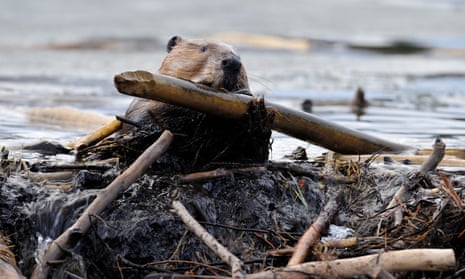The transformation of the rapidly warming Arctic is being accelerated by a wave of thousands of newcomers that are waddling and paddling northwards: beavers.
Scientists who sought to map the spread of beavers in Alaska were astounded to find that the creatures have pushed far north into previously inhospitable territory and are now set to sweep into the furthest northern extremities as the Arctic tundra continues to heat up due to the climate crisis.
“We didn’t know what we would find and ended up being very surprised,” said Ken Tape, an ecologist at the University of Alaska, Fairbanks, who co-authored the new research.
“There are areas of Alaska that had no evidence of beavers 50 years ago that are now apparently saturated with them,” he said, adding: “It’s just a matter of time before they head even further north. When you consider this is likely happening across the rest of the Arctic in Canada and Russia, that gives you an idea of the scope of this change.”
Using aerial photographs and satellite imagery reaching back to 1949, and observations recorded from before then, an international team of researchers involved in the Arctic Beaver Observation Network identified more than 12,000 ponds created by beavers damming rivers and streams across western Alaska. This number has doubled in the past 20 years.
In recent years, as the Arctic has heated up three times quicker than the global average, the North American beaver has ventured north and west and now occupies vast swaths of the Seward peninsula, a large landmass that extends from the western coast of Alaska.
The impact of these portly semiaquatic rodents has been felt by the remote Indigenous communities of Alaska, with the flooded areas created by beavers causing concern over access to food and travel.
It’s unknown how many beavers are now in the northern and western parts of Alaska, with estimates ranging from 50,000 to close to 100,000.
“The true impact of the spread of beavers into the Arctic on the environment and the Indigenous communities who live there is not yet fully known,” said Helen Wheeler, a researcher at Anglia Ruskin University. “However, we do know that people are concerned about the impact beaver dams are having on water quality, the numbers of fish downstream of the dams, and access for their boats.”
A broader consequence of the arrival of beavers could be the acceleration of the climate change which, in combination with a reduction in fur trapping over the past century, has probably allowed the beavers to push north. Beavers, which do not hibernate, have benefited from shortening winters and the wider availability of vegetation available to feed upon.
The pools that accumulate when beavers dam rivers create localized unfrozen “hotpots” that result in the thawing of permafrost, the always-frozen ground of the Arctic that holds vast amounts of carbon. Scientists warn that a widespread thawing of permafrost could cause global heating to spiral dangerously out of control.
“Those ponds absorb heat better, they change the hydrology of the area and the permafrost responds to that,” said Tape. “Beavers are coming in from the outside, imposing themselves on the ecosystem and disrupting it.
“It’s accelerating the effects of climate change. When you realize what’s happened in western Alaska is likely to happen to northern Alaska, it does give you pause.”
Tape said that the Brooks Range, a mountain range that runs across northern Alaska, will be an obstacle to the beavers but will not stop them as they follow rivers up to the north coast.
Further research is under way.
